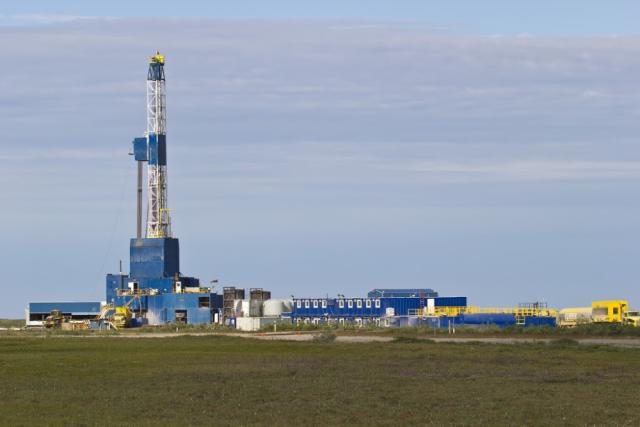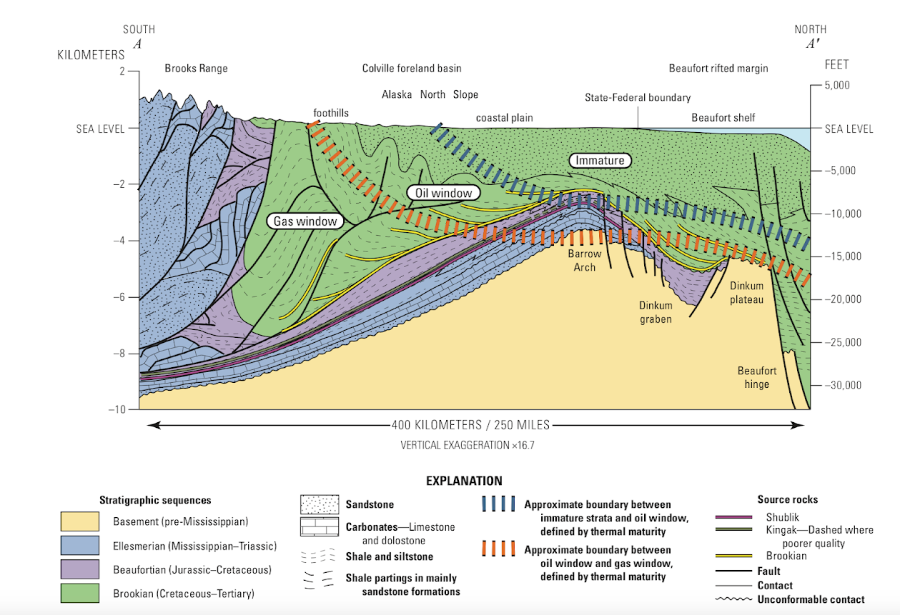
A drilling rig is shown on Alaska's North Slope. (Source: David Gaylor/Shutterstock.com)
Alaska’s Central North Slope, a region already known for its prolific oil and gas assets, still has an estimated 3.6 billion barrels of oil and 8.9 trillion cubic feet of natural gas in conventional resources yet to be discovered.
That’s according to a report released Jan. 23 by the U.S. Geological Survey, which studied six assessment units (AUs) in an area north of Brooks Range, east of the National Petroleum Reserve-Alaska and west of the Arctic National Wildlife.
“Alaska is synonymous with energy, and this assessment just reinforces that,” USGS Director Jim Reilly said in a statement. “The State of Alaska and its industry partners have responsibly produced billions of barrels of oil from Prudhoe Bay, and we think there are still billions more in this region that can be produced.”
Historically, oil exploration has been focused on the Ellesmerian Sequence and the Beaufortian Sequence, which respectively includes the Prudhoe Bay Field’s main reservoirs and the Kuparuk River Field, with smaller oil discoveries along with Barrow Arch, the USGS said in its report.
However, most of the big oil discoveries between 2013 and 2017 have been made at the shallower Brookian Sequence.
“These latest discoveries have stimulated renewed leasing across the central North Slope, suggesting that the Brookian Sequence will be the main focus of exploration in coming years,” the USGS report stated.
Notable discoveries in the Brookian Sequence have included ConocoPhillips Co.’s Willow and Narwhal discoveries and the Horseshoe discovery made by Armstrong Energy LLC and Repsol SA (now operated by Oil Search Ltd.). Both are in the Nanushuk Formation.
Earlier this week, Oil Search—a Papua New Guinea company that has steadily expanded its Alaskan profile—said wireline logs and pressure and fluid sample data show its Mitquq 1 exploration hit hydrocarbon pay in the Nanushuk reservoir interval in the Alaskan Pikka Unit development.
RELATED: Data Indicate Oil, Gas Find In Alaska For Oil Search Ltd.

The USGS report showed that of the AUs covered in the report, the largest undiscovered oil resources were in two Brookian AUs. It, however, cautioned that the estimates include uncertainty.
“The Brookian Topset AU is estimated to hold between 443 and 3,502 MMBO (F95–F5) with a mean of 1,573 MMBO,” the report stated. “The Brookian Foreset–Bottomset AU is estimated to hold between 239 and 2,443 MMBO (F95–F5) with a mean of 975 MMBO.”
Research points to Ellesmerian Strata South and the Beaufortian Strata South as sites of the largest undiscovered conventional gas resources on the Central North Slope.
The USGS reported the Ellesmerian Strata South has a total mean of 2,673 billion cubic feet (Bcf) of natural gas, while the Beaufortian Strata South has. 1,874 Bcf. The estimate is “mainly a reflection of the high thermal maturity of the southern parts of the central North Slope.”
The latest report follows one conducted in 2005. The USGS said since that time a better geological understanding of the rock and resource potential enabled them to focus more on the six AUs.
Recommended Reading
Texas LNG Export Plant Signs Additional Offtake Deal With EQT
2024-04-23 - Glenfarne Group LLC's proposed Texas LNG export plant in Brownsville has signed an additional tolling agreement with EQT Corp. to provide natural gas liquefaction services of an additional 1.5 mtpa over 20 years.
US Refiners to Face Tighter Heavy Spreads this Summer TPH
2024-04-22 - Tudor, Pickering, Holt and Co. (TPH) expects fairly tight heavy crude discounts in the U.S. this summer and beyond owing to lower imports of Canadian, Mexican and Venezuelan crudes.
What's Affecting Oil Prices This Week? (April 22, 2024)
2024-04-22 - Stratas Advisors predict that despite geopolitical tensions, the oil supply will not be disrupted, even with the U.S. House of Representatives inserting sanctions on Iran’s oil exports.
Association: Monthly Texas Upstream Jobs Show Most Growth in Decade
2024-04-22 - Since the COVID-19 pandemic, the oil and gas industry has added 39,500 upstream jobs in Texas, with take home pay averaging $124,000 in 2023.
Shipping Industry Urges UN to Protect Vessels After Iran Seizure
2024-04-19 - Merchant ships and seafarers are increasingly in peril at sea as attacks escalate in the Middle East.




